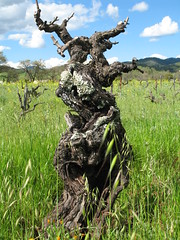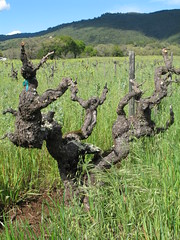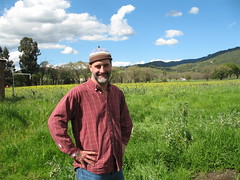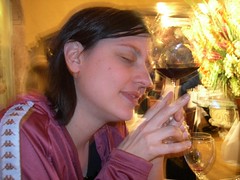Bucklin Vineyard
 As Will Bucklin, Tom Wark and I slogged through the thigh-high mustard, rye grass and legumes, Tom teased Will: "He's given every one of these vines a name." I asked Will if that was true and he said no, not all of them. I told him I was going to call this one Miss Bertha, and he said, "She?"
As Will Bucklin, Tom Wark and I slogged through the thigh-high mustard, rye grass and legumes, Tom teased Will: "He's given every one of these vines a name." I asked Will if that was true and he said no, not all of them. I told him I was going to call this one Miss Bertha, and he said, "She?""Yeah, she," I said. "Look at those curves. You're gonna tell me that's a boy vine? Please."
God, I love old gnarlies. These guys (and girls) look like hell, but they're just gorgeous, all twisted around, stuff growing in, on and out of them. Lizards and mice reside inside their hollowed bases, and Tanner, the vineyard dog, circles one madly trying to get to whatever varmint scuttles within.
 This is the oldest vineyard in Sonoma, founded 155 years ago by William McPherson Hill, the first guy to plant something other than the Mission grapes favored by the Spanish Missionaries. It's a field blend vineyard, meaning there are several different varieties growing together, seemingly willy nilly. Will Bucklin undertook the task of creating a vineyard map (do check this out, it's fascinating) to help illustrate its uniqueness. Perusing this map, I found myself making up theories about why grenache was planted here and the table grapes there, all within a sea of Zinfandel. It's a great bit of California history that surrounds these vines, and one that helped me tie in so many other bits and pieces of that history I'd been picking up on my travels.
This is the oldest vineyard in Sonoma, founded 155 years ago by William McPherson Hill, the first guy to plant something other than the Mission grapes favored by the Spanish Missionaries. It's a field blend vineyard, meaning there are several different varieties growing together, seemingly willy nilly. Will Bucklin undertook the task of creating a vineyard map (do check this out, it's fascinating) to help illustrate its uniqueness. Perusing this map, I found myself making up theories about why grenache was planted here and the table grapes there, all within a sea of Zinfandel. It's a great bit of California history that surrounds these vines, and one that helped me tie in so many other bits and pieces of that history I'd been picking up on my travels.Interview with Will Bucklin, Bucklin Vineyards
C&D: So tell us about your family and the Old Hill Ranch Vineyard.
Will Bucklin: My stepfather purchased the vineyard in 1983, and it was in disrepair, a polite way of putting it...grown over with blackberries, there were old toilets, truck engines, drums of stuff. He was told he wanted to rip the vineyard out because it was worthless, and much to my pleasure, he didn't do that. He ended up farming the vineyard and selling the grapes to Ravenswood and others, and it's been remarkably successful as a single vineyard designate. The vineyard was established in the 1850's, then phyloxera came in in the 1880's, and stretched through the 1920's...one of the arguments I've heard about why this vineyard is probably the oldest in Sonoma is because it's founder, William MacPherson Hill was one of the most advanced agriculturalists, so he would have been one of the first to try and use rootstock (to discourage phyloxera).
How did you come into winemaking, originally?
I went to a community college...it was one of those serendipitous little moments. I was planning on being an engineer, but I don't know what I was thinking because I couldn't do calculus to save my life. So I had this chemistry class and the teacher was an oenofile and all the labs were done around wine, so when we did the pH measurement, we'd use wine, we'd do titratable acidity and use wine, we're doing volatile acidity, we'd use wine. So he loved wine, and I told him about my stepfather, how he had this vineyard and that we lived in Sonoma and I had friends who'd gone to Davis, and he said, "I'll get you into Davis!" And my head just started spinning. So I graduated from Davis, and my stepfather said, you gotta go to Europe, learn not how to make wine but to taste wine, drink wine. So I went and had a great job interview with Baron Phillipe Rothchild, and much to my amazement, I got hired. Met a guy there from Australia, went to Australia to do harvest there, came back, worked at Navarro...worked at King Estate in Oregon for eight years.

We were talking earlier about some of the assumptions we make about old vines...some of those characteristics you might attribute to old vines are actually because of the makeup of the field blend?
The reason that I made the map is that I was out selling my first vintage 2000 and noticed, when I tell people about the age of the vineyard, they get very excited. I tell them about the field blend, and they weren't that impressed. And the wine...the comments were overwhelmingly positive, but they were often critical that it didn't reminisce of Zinfandel. And I thought, how am I going to explain to people how this vineyard is unique, and so that's where the map came from.
And terroir?
Terroir seems to be some of the unchoosables. The things you can't change. I could argue, or not, that (the field blend) is part of this terroir. I guess I could choose not to blend in the other varieties. But, for the sake of argument I could say they were unchangeable, because I'm going to make the wine however that vineyard is.
*****
I got more coming...
Clinkies.
I got more coming...
Clinkies.





0 Comments:
Post a Comment
<< Home